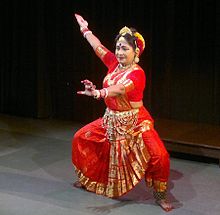Gaudiya Nritya
| Instrument(s) | Anaddha,Ghana,SusirandTata[1] |
|---|---|
| Origin | West Bengal,India |

Gaudiya Nritya(Bengali:Gaur̤īẏa Nṛtyaor Gour̤īyo Nrityo) is a dance tradition.[2][3][4]This dance expressed religious stories[5]through songs written[6]and composed to theragas&talas[7]ofGaudiya musicby ancient poets, especiallyVaishnavism.[8]Gaudiya Nritya performances have also expressed ideas of other traditions related to theHindudeitiesShiva[8]andGanesha,as well asShaktaconcepts.[9]It was reconstructed byMahua Mukherjeein the 1980s and a research scholarship has since been awarded for it by theIndian Ministry of Culture.
Etymology[edit]
On 21 September 1994, The nameGaudiya Nrityawas adopted on the advice ofIndologistBratindra Nath Mukhopadhyay.[10]Reasons for this designation include: in ancient times – thereign of Shashankaand thePalaandSenaeras – the whole of Bengal was referred to asGaudaand the presence of theGaudiya styleinIndian musicandliterature.Also, in the fifteenth century, Sangeet Shastrakar Maheswara Mohapatra of Odisha mentions seven types of dance styles inAbhinaya Chandrikaincluding Gaudiya dance.[11]
History[edit]
The theoretical foundations of Gaurika dance can be found in the ancient Sanskrit textNatyashastra;[12]Its existence in ancient times is attested by dance poses in sculptures of theGaudiya style templeand archaeological sites associated withHinduism,BuddhismandJainismand it is mentioned by ancient poets of Bengal.[13]AfterIndia's independencefrom colonial rule, it underwent revival, reconstruction and expansion in the 1980s.
It has been reconstructed byMahua Mukherjee,a Bengali researcher and dancer.[4][14]A research scholarship was awarded by theMinistry of Culturefor this dance-based research,[15][16]which is mainly offered to recognizedIndian classical dances.Rabindra Bharati UniversityandUniversity of Oklahomahave recognized it as a classical dance form.[17][18][19][20]
References[edit]
- ^Mukherjee 2000,p. 95.
- ^Roma Chatterji (2005).Folklore and the Construction of National TraditionArchivedFebruary 12, 2018, at theWayback Machine.Indian Folklife19(Folklore Abroad: On the Diffusion and Revision of Sociocultural Categories): 9. Accessed January 2014. "a classical dance tradition that has vanished from the urban areas".
- ^"West Bengal Tourism: Dance".Department of Tourism, Government of West Bengal. 2011. Archived fromthe originalon October 21, 2013.RetrievedJanuary 11,2014.
- ^abBharatram, Kumudha (April 9, 2011)."Dance of the ancients".The Hindu.RetrievedNovember 15,2013.
- ^Mukherjee 2000,p. 179.
- ^Mukherjee 2000,pp. 199–201.
- ^Mukherjee 2000,p. 201.
- ^abMukherjee 2000,p. 185.
- ^Mukherjee 2000,p. 181.
- ^Mukherjee 2000,p. 1.
- ^Mukherjee 2000,pp. 1–2.
- ^Mukherjee 2000,pp. 144–145.
- ^Mukherjee 2000,pp. 5–40.
- ^Rajan, Anjana (December 26, 2006)."The wheel has come full circle".The Hindu.Archived fromthe originalon November 8, 2012.
- ^"Gaudiya Nritya".INDIAN CULTURE.RetrievedJanuary 25,2022.
- ^"Scholarship to Young Artistes, 2005".Ministry of Culture. Government of India. Archived fromthe originalon October 21, 2013.
- ^"Feet forgotten and found".www.telegraphindia.com.RetrievedJanuary 25,2022.
- ^Utpal Kumar Banerjee (2006).Indian performing arts: a mosaic.New Delhi: Harman Publishing House.ISBN9788186622759.p. 79: "re-creating Gaudiya Nritya as one of the acceptable classical styles will need a formal framework".
- ^Leela Venkataraman (2006).Negotiating the Extremes: dance.India International Centre Quarterly,33(1): 93-102.(subscription required)"one may have reservations about the classical dance repertoire visualised by [Mukherjee]".
- ^Roma Chatterji (2005). p. 9: "Mukherjee tries to reconstitute a Bengali aesthetic within the perspective of pan-Indian civilisation".
Bibliography[edit]
- Sengupta, Pallab; Banerjee, Manabendu; Mukherjee, Mahua, eds. (December 2005).Gaudiya Dance: A Coolection of Seminar Papers.1 Park Street, Kolkata: The Asiatic Society.
{{cite book}}:CS1 maint: location (link) - Mukherjee, Mahua (January 2000).Gaur̤īẏa Nṛtyaগৌড়ীয় নৃত্য[Gaudiya Dance] (in Bengali). 1 Park Street, Kolkata:The Asiatic Society.
{{cite book}}:CS1 maint: location (link)
External links[edit]
![]() Media related toGaudiya Nrityaat Wikimedia Commons
Media related toGaudiya Nrityaat Wikimedia Commons


